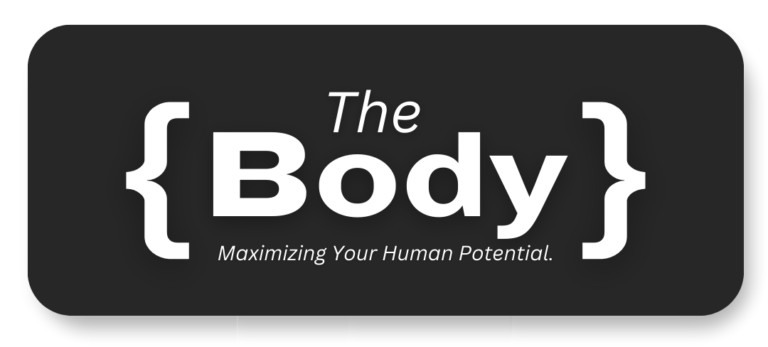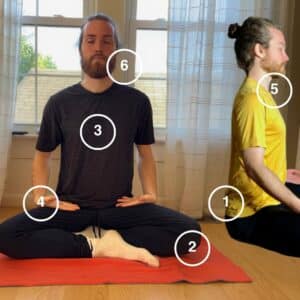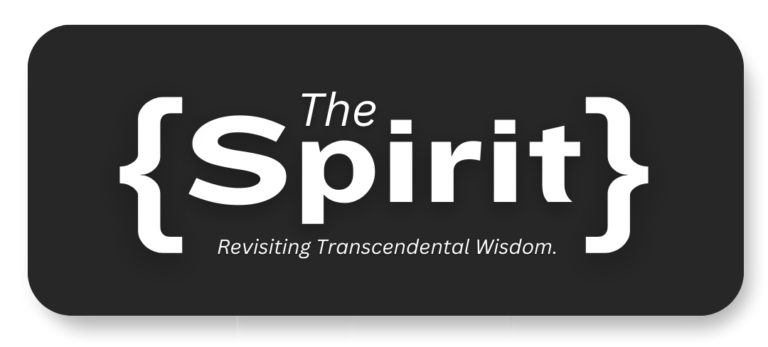Meditation Posture, Time-Bound Thoughts and The Yoga Sutras (Part 4)
April 14, 2024

Best posture for seated meditation.
Topic submitted by: Eli H. from Charlotte, NC
Due to the mind-body connection, your meditation posture directly affects your ability to quiet the mind.
Below is a picture of the “correct” meditation posture (note: I’ll give you some modifications [in brackets] if your body isn’t this open yet).

- Your pelvis should be tilted. [Feel free to throw a cushion underneath your bum to help.]
- If you can get your knees on the ground, great — this gives you more leverage to push upwards. [If not, no worries. Keep stretching your hips, and consider sitting in a chair until you can comfortably sit with knees touching the ground.]
- Your spine should be strong and upright so that the rest of your body can relax. A nice analogy is: “Needle in Cotton.” Your spine is the needle — strong and pointed — and your extremities are the cotton — soft like a cloud. [Holding a plank pose is a great way to strengthen your spinal muscles.]
- Place your hands palm facing up in the fold of your quads and stomach. It will be slightly uncomfortable for your wrists at first, but is the most effective way to get your shoulders back and down. [Palms facing down on the middle of your thighs is the second best option.]
- Keep your chin horizontal to the ground. [Imagine a string pulling the crown of your head upwards.]
- Draw your ears back by pushing your tongue to the roof of your mouth (as though you were making an “ng” sound) and lightly raising your eyebrows. [Imagine your sinus cavities expanding.]
Practice
I include over 15 different analogies, metaphors and visualization experiments in my “Perfect Posture” workshop. I got a lot of great feedback from it.
Purchase the recording and practice audios by clicking here.

Getting rid of past and future thoughts.
Topic submitted by: Renee C. from Atlanta, GA
It’s believed that the “goal” of meditation is to become permanently present — to do away with past and future in order to free our minds from their time-bound grasp.
The sentiment behind this idea is right on, but there are exceptions to the past/future rule that can actually bring you closer to this liberation.
For instance, used correctly, memory is actually an ally — not an enemy — on your path towards enlightenment.
By reflecting back on times of unconditional peace or love, you are inspired to continue renouncing your momentary sense pleasures for the higher highs of God-inspired joy.
Or by simply remembering times of suffering, you gather fuel necessary to cut the chords of your attachments, once and for all.
Expectation, too, (which is often poo-poo’d by meditators) can work for your spiritual benefit. Because of how the mind works, expecting to become wiser, kinder and more enlightened, actually helps you become wiser, kinder and more enlightened!
So while it is eventually necessary for you to detach from all thoughts of past and future, you don’t have to throw them out just yet. In the meantime, you can observe these kinds of time-bound thoughts carefully to discover what lessons, beliefs or desires are propping them up.

“Vrtti sārūpyam itaratra.” — Yoga Sutras [1.4]
Quote submitted by: Josiah M. from Bali, Indonesia
This is part 4 of 4 on a series about the Yoga Sutras. Click to read part 1, part 2, or part 3.
According to the Yoga Sutras, yoga is the practice of stilling the fluctuations of your mind so that you can rest in unconditional peace.
The only alternative to this achievement — according to Sutra 1.4 — is that “the Seer takes the form of the modifications of the mind,” or “vrtti sārūpyam itaratra.”
Said differently: if you don’t learn how to restrain your thoughts, you are bound to identify with them, believing them to be who you are!
Let’s unpack that second part.
If someone were to ask “who are you?”, what would you say to them?
Would you respond with your name? Hi, I’m Ethan.
Or would you answer with your age, role in society, or city? I’m a 27 year old yoga teacher from Asheville, North Carolina.
Or would you reply with beliefs you hold, memories that shaped perspective, or aspirations you have? I’m someone who tries not to adhere to labels, because of the profound meditation experiences I’ve had; I’m trying to help others discover their changeless essence, too.
But what if you changed your name? Would you still be you?
And what about when you get to be in your 80s? Or when you inevitably change professions? Or when you move cities? Would you still be you?
And what happens if your opinion is proven wrong? Or if you lose all of your memories? Or if you shift your priorities? Would you still be you?
Obviously the answer is yes. Whether you lose waking consciousness under anesthesia, or you change your gender, or you renounce all prior engagements to become a monk in a cave, you will very likely still have the felt sense of being “me”.
This, then, is the constant tension you’re under: you know (theoretically, at least) that you’re not your thoughts and stories, and yet you keep identifying with them! You keep confusing yourself to be the mind, instead of the Presence behind the mind.
The ancient science of yoga was created to help you with this problem. By slowing your mind down through stretching, breathwork and meditation, you are given an opportunity to trade in your temporary identities for an everlasting One.
I hope you enjoyed this 4-part series on the Sutras. If you have a particularly enlightening paragraph/quote you’d like me to explore next, please submit it below.

100% free • unsubscribe anytime





